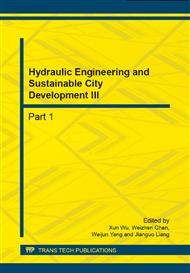[1]
F. Porikli and X. Li. Traffic congestion estimation using HMM models without vehicle tracking [J]. Mitsubishi Electric research Laboratories, IEEE Intelligent Vehicles Symposium(2004).
DOI: 10.1109/ivs.2004.1336379
Google Scholar
[2]
JIANG Guiyan. Technologies and applications of the identification of road traffic conditions [M]. Beijing: China Communications Press, (2004), pp.3-5.
Google Scholar
[3]
DUAN Houli, LI Zhiheng, LI Li, et al. Network-wide traffic state observation and analysis method using pseudo-color map[J]. Journal of Transportation Systems Engineering and Information Technology, vol. 9(4), (2009), pp.46-52.
DOI: 10.1016/s1570-6672(08)60071-9
Google Scholar
[4]
Kerner B S, Demir C, Herrtwich R G, et al. Traffic state detection with floating car data in road networks[C]/ Proceedings of the 8th International IEEE Conference on Intelligent Transportation Systems. Vienna, Austria, (2005), pp.700-705.
DOI: 10.1109/itsc.2005.1520133
Google Scholar
[5]
Ruey L C, Chi X, DerHorng L.Probe vehicle population and sample size for arterial speed estimation[J].Computer-aided Civil and Infrastructure Engineering, vol. 17(1) , (2002), pp.53-60.
DOI: 10.1111/1467-8667.00252
Google Scholar
[6]
Sarvi M, Horiguchi R, Kuwahara M, et al. A methodology to identify traffic condition using intelligent probe vehicles[C]/ Proceedings of the 10th ITS Word Congress. Madrid, (2003), pp.17-21.
Google Scholar
[7]
WENG Jian-cheng, RONG Jian, YU Quan, etc. Optimization on estimation algorithms of travel speed based on the real-time floating car data[J]. Joural of Beijing University of Technology, vol. 33(5) , (2007), pp.459-464.
Google Scholar
[8]
ZHANG Cunbao, YANG Xiaoguang, YAN Xinping. Traffic data collection system based on floating cars[J]. Transportation and computer, vol. 24(5), (2006), pp.31-34.
Google Scholar
[9]
Stathopoulos A, Karlaftis M G. A multivariate state space approach for urban traffic flow modeling and prediction[J]. Transportation Research Part C: Emerging Technologies, vol. 11(2), (2003), pp.121-135.
DOI: 10.1016/s0968-090x(03)00004-4
Google Scholar
[10]
QU Zhaowei, WEI Qiang, BIE Yiming, etc. Method for traffic state identification based on fixed detector [J]. Journal of Central South University(Science and Technology), vol. 44(1), (2013), pp.403-410.
Google Scholar
[11]
Geroliminis N, Daganzo C F. Existence of urban-scale macroscopic fundamental diagrams: Some experimental findings[J]. Transportation Research Part B: Methodological, vol. 42(9), (2008), pp.759-770.
DOI: 10.1016/j.trb.2008.02.002
Google Scholar
[12]
ZOU Liang, XU Jian-min, ZHU Ling-xiang, etc. Estimation model of travel time based on fusion technique from probe vehicle and crossing data[J]. Journal of Highway and Transportation Research and Development, vol. 24(6), (2007), pp.114-117.
Google Scholar


